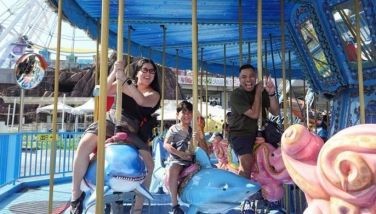Benham Rise 2: Plans A to H
(Conclusion)
We identified the most experienced divers among us who would dive to the site first; we assigned who would lay out the fifty-meter long transect line along which all the fish and coral surveys would be done; and we delegated various tasks such as video documentation, still photography, fish surveys, coral identification, and sediment sampling to the other members of the team.
Everybody knew what each had to do and the protocol seemed easy and hardly challenging. We’ve done this at this depth in the coastal zones countless times before. However, at the first site where we dropped anchor at Benham Rise, jaws dropped with incredulity. A deployment of a weighted video cam and a dive computer at the site confirmed what the ship’s instruments initially indicated – we were looking at a site that was three times deeper than what we had anticipated! One hundred eighty feet – and this was the shallowest point they found.
We hurriedly huddled in the conference room, agreed to make a judgment call and came up with a diving plan B (replaced by plan C and all the way up to plan H in the next days as we had to carefully rethink our strategy prior to every dive). At this depth, we realized that the maximum time we could spend at the bottom was only five minutes and this additionally required up to half an hour of decompression time at several depths on the ascent to allow for the elimination for non-oxygen gases from the bloodstream. We took turns diving to the bottom to do very specific tasks and had the diving safety officers positioned at the three safety stops (60, 40 and 15 feet) to assist the others as they clung to the guide rope for their decompression stops. The diving plan was strictly enforced.
Anyone, not sparing the project leader, who deviated from the plan was “grounded” in the succeeding dives.
Diving to reach Benham’s bottom was a unique experience. One had to descend fast to maximize the air contained in the scuba tank, yet, one also had to equalize frequently to prevent the painful ear squeeze that is felt with every five-meter descent. As one went deeper, the world gradually shifted into a monochromatic bluish gray as the longer wavelengths (such as red and orange) got absorbed in the upper layers of water. The pressure also increased with depth and rendered any movement to be a bit sluggish and the nitrogen that got dissolved in one’s bloodstream reached the brain, causing a mild narcosis.
The world at the sea bottom was surreal and dreamlike. One had to exert a conscious effort to stay focused on the task at hand – be it a fish survey, a sample collection or a videographic documentation – lest one completely forgot what he was supposed to do at that depth and came back to the surface having accomplished nothing.
Contrary to my expectations of deep-water habitats, the bottom was appreciably well illuminated because of the clear waters of the Pacific Ocean. The landscape at the bottom was a coral reef that was in very good condition, something rarely encountered now anywhere in the country. Every available space was occupied by tiers of plate-like corals, spreading to maximize their surface area in order to catch as much of the sunlight that was filtering down from the surface.
Sun-loving Halimeda seaweeds also grew in patches, shedding bits of calcified sand as each frond reached the end of its life. Fish also abounded in the area but stayed at a safe distance and kept a wary eye on the land-dwelling intruders. This was my first glimpse of, and intrusion into, a mesophotic or twilight reef, a deep-water ecosystem that receives just enough light to support sunlight-dependent organisms such as corals and seaweeds. This was a world that has remained practically untouched by man, at least until we came.
*An earlier version of this article appears in the June 2014 issue of Ti Similla, the faculty newsletter of UP Baguio. http://www.upb.edu.ph/
* * *
Romeo M. Dizon, Ph.D. is an assistant professor of biology at the University of the Philippines Baguio. His research interests are coral ecology and coral restoration ecology. E-mail: romdizon@gmail.com.
- Latest
















